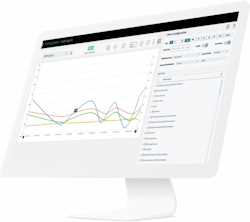There is so much data coursing through the plant these days, due in large part to the addition of smart devices associated with the Internet of Things (IoT). But what does all of this data really mean to the average machine operator? Seasoned plant floor professionals will understand the irregular naming conventions of “tags” that correlate to signals coming from the equipment. But for the new operator just starting out, tag “ALB_BLDG1_L1_M47_DISPUMP1_RPM,” means absolutely nothing.
For today’s fast-paced, mobile workforce, data needs context. And that is exactly what GE Digital has provided in the latest version of its Proficy Historian. The new functionality in Proficy Historian 8.0 includes the ability to map data between the tag and a representation of a machine, a line, or the entire plant to create an “asset model.” This model includes standard object types that hold the information associated with the equipment and adds context to the data.
“Now you can map tags to objects in the asset model and use plain language descriptions for what the tags in the historian mean,” said Steve Pavlosky, principal product manager for Proficy Historian at GE Digital. In addition, by using web-based development tools, like REST APIs, individuals can build mini applications, link them together, and share them with their peers.
According to Pavlosky, the next-generation of workers—who are digital natives—are comfortable creating queries and doing screen layouts, so GE Digital is delivering a tool that allows the customer to interact with GE data sources and business data sources. “Through REST APIs, we bring it together in a no code application environment. [Users] can lay out trends, tables, and data collection forms in a simple way, getting it out of the hands of the control engineers who traditionally built HMI SCADA systems, and giving a broader set of operational people access to tools to build the screens to do the job more effectively and share it across the operation. For us, this is a sea change for how we allow customers to get value from data.”
In addition, a visual component of the software is a responsive design HTML5 app builder which allows the user to define the app for different layouts, depending on the type of device—from the desktop to a smart watch. This allows the visualization of trends to put a piece of data into context with other things associated with the machine or plant environment. GE Digital is also providing MQTT data collection for smart sensors to store that data along with other information coming out of a PLC, for example, to have one normalized data set.
“We are taking technology built for the cloud and deploying it on premise to make it easier for a broader set of users to create visibility to the data,” Pavlosky said.
The Proficy Historian software is tightly integrated with GE Digital’s Proficy HMI/SCADA applications, including Cimplicity and iFIX, and Proficy Manufacturing Execution Systems. This integration enables operators to manage machinery and plant processes. GE Digital also introduced a Linux-based Proficy Historian earlier this year that creates a standard time-series product for edge analytic applications. The Linux version of Proficy Historian changes data collection by pushing machine data to the plant level instead of polling from higher level systems, providing a new, more efficient mechanism, the company said.
Proficy Historian 8.0 is the latest update in GE Digital’s product innovation plan that follows a number of other recent investments geared toward unlocking the power of Industrial IoT, including edge-to-cloud analytics and improving operator mobility.
Read more about GE Digital's transformation:
Leaders relevant to this article:

